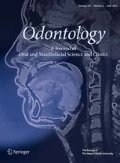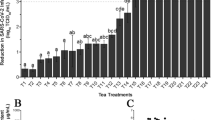Abstract
Bacterial colonization in the oral cavity is critical for efficient action of probiotics. However, limited colonization rates have been reported in many clinical trials. The aim of this pilot clinical study was to evaluate the colonization efficiency of Streptococcus dentisani under different dosing schedules and pre-treatment conditions. Eleven adult volunteers enrolled in the study. A professional ultrasound cleaning was performed in quadrants 1 and 4. The probiotic was applied in all four quadrants at a total dose of 1010 CFUs, administered in a buccoadhesive gel for 5 min, either in a single dose (n = 5) or daily for a week (n = 6). Dental plaque and saliva samples were collected at baseline and after 14 and 28 days of first application. Amounts of S. dentisani and the cariogenic organism Streptococcus mutans were measured by qPCR and salivary pH was measured by reflectometry. There was a significant increase in S. dentisani cells at day 14 but not at day 28 under both dosing schedules. A non-significant higher colonization was found in the half-mouth with previous professional cleaning as compared to the intact half. There was a significant increase in salivary pH at day 14 (p = 0.024) and day 28 (p = 0.014), which was stronger in multi-dose patients, and a significant decrease in S. mutans at day 28 (p < 0.01). The results indicate that S. dentisani is transiently able to colonize the oral cavity and that it buffers oral pH, especially after multiple dosing. Future randomized, placebo-controlled clinical trials should evaluate its use to prevent tooth decay.




Similar content being viewed by others
References
Ravn I, Dige I, Meyer RL, Nyvad B. Colonization of the oral cavity by probiotic bacteria. Caries Res. 2012;46:107–12.
Taipale T, Pienihäkkinen K, Salminen S, Jokela J, Söderling E. Bifidobacterium animalis subsp. lactis BB-12 administration in early childhood: a randomized clinical trial of effects on oral colonization by mutans streptococci and the probiotic. Caries Res. 2012;46:69–77.
Allaker RP, Stephen AS. Use of probiotics and oral health. Curr Oral Health Rep. 2017;4:309–18.
Hoare A, Marsh PD, Diaz PI. Ecological therapeutic opportunities for oral diseases. Microbiol Spectr. 2017. https://doi.org/10.1128/microbiolspec.bad-0006-2016.
Ley RE, Hamady M, Lozupone C, Turnbaugh PJ, Ramey RR, Bircher JS, Schlegel ML, Tucker TA, Schrenzel MD, Knight R, Gordon JI. Evolution of mammals and their gut microbes. Science. 2008;20:1647–51.
Jacobsen CN, Rosenfeldt Nielsen V, Hayford AE, Møller PL, Michaelsen KF, Paerregaard A, Sandström B, Tvede M, Jakobsen M. Screening of probiotic activities of forty-seven strains of Lactobacillus spp. by in vitro techniques and evaluation of the colonization ability of five selected strains in humans. Appl Environ Microbiol. 1999;65:4949–56.
Morales A, Carvajal P, Silva N, Hernandez M, Godoy C, Rodriguez G, Cabello R, Garcia-Sesnich J, Hoare A, Diaz PI, Gamonal J. Clinical effects of Lactobacillus rhamnosus in non-surgical treatment of chronic periodontitis: a randomized placebo-controlled trial with 1-year follow-up. J Periodontol. 2016;87:944–52.
López-López A, Camelo-Castillo A, Ferrer MD, Simon-Soro Á, Mira A. Health-associated niche inhabitants as oral probiotics: the case of Streptococcus dentisani. Front Microbiol. 2017;8:379.
Badet C, Thebaud NB. Ecology of lactobacilli in the oral cavity: a review of literature. Open Microbiol J. 2008;2:38–48.
Mantzourani M, Fenlon M, Beighton D. Association between Bifidobacteriaceae and the clinical severity of root caries lesions. Oral Microbiol Immunol. 2009;24:32–7.
Pham LC, van Spanning RJ, Röling WF, Prosperi AC, Terefework Z, Ten Cate JM, Crielaard W, Zaura E. Effects of probiotic Lactobacillus salivarius W24 on the compositional stability of oral microbial communities. Arch Oral Biol. 2009;54:132–7.
Marsh PD. In sickness and in health-what does the oral microbiome mean to us? An ecological perspective. Adv Dent Res. 2018;29:60–5.
Mira A. Oral microbiome studies: potential diagnostic and therapeutic implications. Adv Dent Res. 2018;29:71–7.
Bao X, de Soet JJ, Tong H, Gao X, He L, van Loveren C, Deng DM. Streptococcus oligofermentans inhibits Streptococcus mutans in biofilms at both neutral pH and cariogenic conditions. PLoS One. 2015. https://doi.org/10.1371/journal.pone.0130962.
Burton JP, Chilcott CN, Moore CJ, Speiser G, Tagg JR. A preliminary study of the effect of probiotic Streptococcus salivarius K12 on oral malodour parameters. J Appl Microbiol. 2006;100:754–64.
Huang X, Schulte RM, Burne RA, Nascimento MM. Characterization of the arginolytic microflora provides insights into pH homeostasis in human oral biofilms. Caries Res. 2015;49:165–76.
Huang X, Palmer SR, Ahn SJ, Richards VP, Williams ML, Nascimento MM, Burne RA. A Highly arginolytic Streptococcus species that potently antagonizes Streptococcus mutans. Appl Environ Microbiol. 2016;82:2187–201.
Camelo-Castillo A, Benítez-Páez A, Belda-Ferre P, Cabrera-Rubio R, Mira A. Streptococcus dentisani sp. nov., a novel member of the mitis group. Int J Syst Evol Microbiol. 2014;64:60–5.
Choi EJ, Lee SH, Kim YJ. Quantitative real-time polymerase chain reaction for Streptococcus mutans and Streptococcus sobrinus in dental plaque samples and its association with early childhood caries. Int J Paediatr Dent. 2009;19:141–7.
Georgios A, Vassiliki T, Sotirios K. Acidogenicity and acidurance of dental plaque and saliva sediment from adults in relation to caries activity and chlorhexidine exposure. J Oral Microbiol. 2015;7:26197.
Conrads G, Bockwoldt JA, Kniebs C, Abdelbary MMH. Commentary: health-associated niche inhabitants as oral probiotics: the case of Streptococcus dentisani. Front Microbiol. 2018;9:340.
Llena C, Almarche A, Mira A, López MA. Antimicrobial efficacy of the supernatant of Streptococcus dentisani against microorganisms implicated in root canal infections. J Oral Sci. 2019;61:184–94.
Esteban-Fernandez A, Ferrer MD, Zorraquin I, Lopez-Lopez A, Moreno-Arribas V, Mira A. In vitro beneficial effects of Streptococcus dentisani as potential oral probiotic for periodontal diseases. J Periodontol. 2019;. https://doi.org/10.1002/JPER.18-0751.
Caillard R, Lapointe N. In vitro gastric survival of commercially available probiotic strains and oral dosage forms. Int J Pharm. 2017;519:125–7.
Conrads G, Westenberger J, Lürkens M, Abdelbary MMH. Isolation and bacteriocin-related typing of Streptococcus dentisani. Front Cell Infect Microbiol. 2019;9:110.
Srinivasan S, Nandlal B, Rao MVS. Assessment of plaque regrowth with a probiotic toothpaste containing Lactobacillus paracasei: a spectrophotometric study. J Indian Soc Pedod Prev Dent. 2017;35:307–11.
Hedayati-Hajikand T, Lundberg U, Eldh C, Twetman S. Effect of probiotic chewing tablets on early childhood caries—a randomized controlled trial. BMC Oral Health. 2015;15:112.
Acknowledgements
We thank AB-Biotics SA (Sant Cugat del Valles, Barcelona, Spain) for supplying the lyophilized material, performing the tests on the probiotic composition and developing the final administered product. We are also thankful to the University of Valencia Dental Clinic, run by the Lluis Alcanyis Foundation, for providing the facilities and general infrastructure for running the clinical trial. We thank Alejandro Artacho for help with statistical analysis and Jordi Espadaler for critically revising the manuscript.
Author information
Authors and Affiliations
Corresponding author
Ethics declarations
Conflict of interest
Funding was provided by grant RTC-2015-4292-1 from the RETOS-Colaboracion Call of the Spanish Ministry of Health and Competitiveness. Alex Mira is the inventor of a patent protecting the use of S. dentisani as a probiotic to promote oral health. The other authors declare they have no conflict of interest.
Additional information
Publisher's Note
Springer Nature remains neutral with regard to jurisdictional claims in published maps and institutional affiliations.
Rights and permissions
About this article
Cite this article
Ferrer, M.D., López-López, A., Nicolescu, T. et al. A pilot study to assess oral colonization and pH buffering by the probiotic Streptococcus dentisani under different dosing regimes. Odontology 108, 180–187 (2020). https://doi.org/10.1007/s10266-019-00458-y
Received:
Accepted:
Published:
Issue Date:
DOI: https://doi.org/10.1007/s10266-019-00458-y




